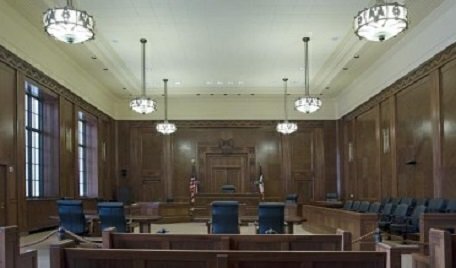In 1963, veteran police officer Martin McFadden noticed three men behaving suspiciously outside of a jewelry store in Cleveland, Ohio. The men were pacing back and forth, repeatedly stopping to look inside the same store. After observing this behavior, McFadden decided to approach the three men. He identified that he was a police officer and asked for their names. After the men “mumbled something” in response, McFadden performed an exterior search (a pat down) of the men to ensure his safety. During the pat down, McFadden felt a weapon through the clothing of John Terry, which he then removed. He performed a pat down of the other two men and found that Richard Chilton was also carrying. Both men were charged with the illegal possession of a concealed firearm.
 During the subsequent trial, attorneys for Terry and Chilton argued that the weapons were obtained by Officer McFadden illegally via an unreasonable search and seizure in violation of the Fourth Amendment. They further argued that the weapons were inadmissible as evidence in the case due to the exclusionary rule. The court rejected the argument, and the pistols were used as evidence in support of conviction. Terry’s defense team appealed to the Supreme Court of Ohio, but to no avail. The case was appealed to the U.S. Supreme Court.
During the subsequent trial, attorneys for Terry and Chilton argued that the weapons were obtained by Officer McFadden illegally via an unreasonable search and seizure in violation of the Fourth Amendment. They further argued that the weapons were inadmissible as evidence in the case due to the exclusionary rule. The court rejected the argument, and the pistols were used as evidence in support of conviction. Terry’s defense team appealed to the Supreme Court of Ohio, but to no avail. The case was appealed to the U.S. Supreme Court.
Terry v. Ohio was controversial and substantial for a number of reasons. The state argued that McFadden had reasonable suspicion that a crime was about to take place, and therefore that it was also reasonable to think that the defendants could be armed and dangerous. But until McFadden felt a gun through Terry’s clothing, the only evidence of a crime being committed was said suspicion. To what extent does the Fourth Amendment protect citizens on the street? Is there a constitutionally significant difference between a “stop” and an “arrest,” between a “frisk” and a “search”? In a search or seizure, when is “reasonable suspicion” enough, and when is “probable cause” required? In this particular case, were the discovered weapons inadmissible in court?
In 1967, the Court heard oral arguments, and on June 10, 1968, an 8-1 majority ruled in favor of the state. The opinion was penned by Chief Justice Earl Warren, with concurring opinions from both Justices John Marshall Harlan and Byron White.
Early on, Warren took pains to be fair and even-handed. He presented the best arguments on both sides: the need for “an escalating set of flexible responses” for police in dangerous situations,” versus the need for a “specific justification for any intrusion upon protected personal security” of the citizen. He even gestured to contemporary debates over stop and frisk, calling it “a serious intrusion upon the sanctity of the person, which may inflict great indignity and arouse strong resentment.” This procedure, he wrote, “is not to be undertaken lightly.”
The Court then made its first key move: “Stops” and “frisks” are rightly considered “seizures” and “searches,” respectively, under the Fourth Amendment. To believe otherwise, writes Warren, is “to isolate from constitutional scrutiny the initial stages of the contact between the policemen and the citizen.”
Terry’s victory was short-lived, however, because the Court subsequently made another key move: McFadden’s stop and frisk—“necessarily swift action predicated upon the on-the-spot observations of the officer on the beat”—does not, and as a practical matter cannot, require a warrant. Instead, his behavior should be tested by the Fourth Amendment’s general prohibition against “unreasonable” searches and seizures.
In this analysis, the Court made a distinction: It was reasonable for McFadden to believe that Terry and his companions were armed and thus a threat to McFadden’s safety. (Indeed, any “reasonably prudent man” would reach the same conclusion.) When this justification is balanced against the scope of the intrusion – in this case, the patting down of outer clothing – the search is deemed reasonable, as it was “minimally necessary” for discovering weapons and stopped short of a general search. Ultimately, then, the weapons were admissible in court.
The lone dissenter, Justice William O. Douglas, lamented the new – lower – standard for warrantless arrests. Instead of “probable cause,” the long-endorsed standard for searches and seizures, only “reasonable suspicion” was now required, which would give the police, not a judge, greater discretion in authorizing searches







